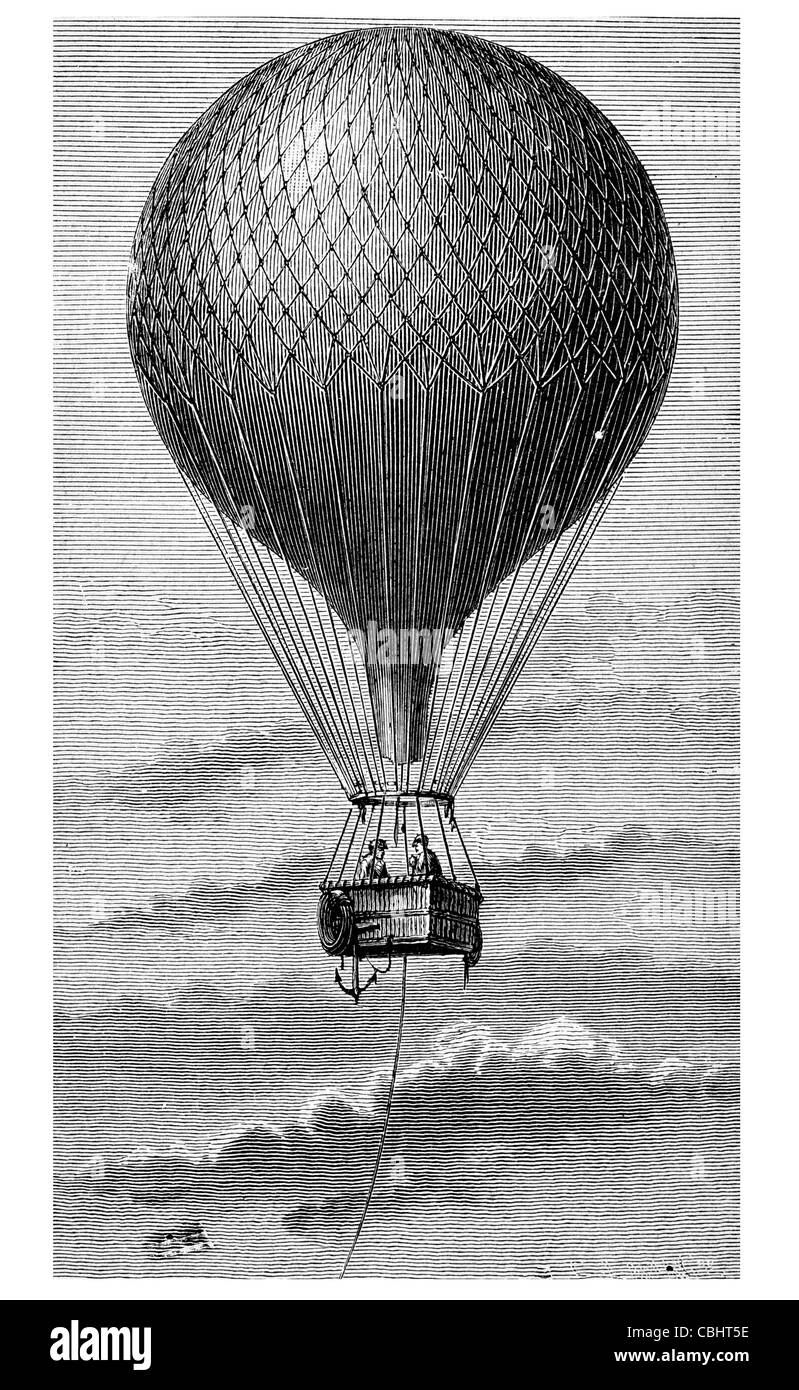Balloon Aircraft - A barrage balloon is a large unmanned tethered balloon used to protect ground targets from attack by aircraft by raising high steel cables that pose a serious collision threat to the aircraft, making it more difficult for an attacker to approach. Early inflatable balloons were often spherical. The design of the kite balloon, with its shape and rope restrictions to stabilize the balloon and reduce drag, allows it to be used at higher wind speeds than a ball balloon. Some examples had small explosive charges that were pulled against the aircraft to ensure its destruction. Expansion balloons are not practical against very high flying aircraft due to the weight of the long cable.
France, Germany, Italy and Great Britain used inflatable balloons during the First World War. While the French and German forces developed kite balloons, the early British inflatable balloons were spherical.
Balloon Aircraft

Sometimes, especially around London, several balloons were used to raise a "barrier net" in which a steel cable was strung between the balloons and many more cables hung from it. These nets could be raised to a height comparable to the operational ceiling of bombers of the time (15,000 ft / 4,500 m). By 1918, hot air balloons were 50 miles (80 km) around London, and captured German pilots expressed great fear of them.
Hot Air Balloons And Airplanes
Landing ships carrying cargo ashore on one of the invasion beaches during the Battle of Normandy. Note the balloons raised by the 320th Balloon Battalion.
In 1938, the British Balloon Command was established to protect cities and important targets such as industrial areas, ports and harbors. The balloons were designed to attack dive bombers flying at altitudes of up to 5,000 feet (1,500 m), to force them to fly higher and within range of airport fire: anti-aircraft guns could not quickly penetrate the attack planes that were on low altitude flying and high speed. By mid-1940 there were 1,400 hot air balloons, a third of them over the London area.
Although dive bombing was a devastatingly effective tactic against undefended targets such as Guernica and Rotterdam, dive bombers were very vulnerable to fighter attacks while diving, and Germany used them in this role against Britain with their effective Royal. The air force was quickly terminated. The balloons were of little use against the advanced German bombers that replaced the dive bombers, but continued to be produced until nearly 3,000 were produced in 1944. They proved effective against the V-1. a flying bomb that normally flew at or below 2,000 feet (600 m), but had wire cutters on its wings to combat the balloons. It is officially claimed that 231 V-1s were destroyed by the balloons.
The British added two improvements to their balloons: "Double Parachute Link" (DPL) and "Double Parachute/Ripping" (DP/R). The first was triggered by a shock caused by the impact of an emy bomber that caught a cable, causing that part of the cable to be explosively released by parachute either d; the combined weight and drag that cause the plane to fall. The latter was intended to make the balloon safe if it accidentally went off. The heavy sea cable would detach from the balloon and fall to the ground under the parachute; at the same time, a panel is torn off the balloon, causing it to deflate and fall well to the ground.
Custom Inflatable Advertising Plane Balloon
In January 1945, during the Royal Navy fleet air force attacks on the Palembang oil refineries, British aircrew were surprised by the massive use of inflation balloons on Japanese defenses. They were spherical and smaller than the British type. One Grumman Avger was destroyed and its crew was killed when the balloon was struck by a cable.
"The top of the balloon was filled with hydrogen, the bottom half was left empty, so when it was set up at a certain height, it was filled with natural air," said Dorothy Brannan, an inflation balloon volunteer based in Portsmouth.
In 1942, Canadian and American forces began joint operations to capture the Sault Ste. Marie along their common border between the Great Lakes against a possible air attack.

During severe storms in August and October 1942, some of the expansion balloons burst and trailing cables shorted the power lines, causing some localized disruptions to mining and production.
Hot Air Balloon Drawing Vector Illustration. Graphic Isolated Colorful Aircraft. Crayon Pencil Sketch Stock Vector Image & Art
In particular, the production of metals was disrupted. Canadian military records show that one of the more serious incidents, known as the "October Incident", caused an estimated 400 tonnes (390 long tons; 440 short tons) of steel and 10 tonnes (9.8 long tons; 11 short tons) of damage. ) of ferrous alloys. The winter weather probably also played a part.
The lessons learned from the deployed balloons led to Operation Outward, which was the deliberate release of balloons traveling behind conductive cables to cut off power supplies to occupied continental Europe.
En route to Aachen, West Germany in 1944, the British 2nd Field Forces captured Aachen on October 21, 1944. In contrast, during the First Army's advance from Oachen to nearby Dür, inflatable balloons were bombarded to mark the location of enemy forces floating east.
After the war, some of the excess inflation balloons were used as tethered balloons for nuclear weapons testing throughout the period that nuclear weapons were tested in the atmosphere. The gun or round was carried to the required height under the expansion balloon, allowing test firings to be conducted under controlled conditions at heights much higher than test towers. Several experiments in the Operation Plumbbob series were carried to altitude using inflatable balloons. An airship or dirigible balloon is a type of aerostat or lighter-than-air aircraft that can navigate through the air under its own power.
Balloons Above The Battlefield: How Gray Army Airfield Is Steeped In Army Balloon Aviation History
Early airships used hydrogen as a lifting gas because of its high lifting capacity and easy availability. Helium gas has almost the same lift and is not flammable, unlike hydrogen, but is rare and relatively exclusive. Significant quantities were first discovered in the United States, and for a time helium was only available for airships in that country.
The velocity of an airship may form a gas bag or it may contain several gas-filled elements. The airship also has lines, crew, and optional load-bearing accommodation, which are usually suspended in one or more nacelles below the rim.
Non-rigid airships, often called "blimps," rely on internal pressure to maintain their shape. Semi-rigid airships maintain their rim shape through internal pressure, but have some form of support structure, such as a fixed keel. Rigid airships have an outer structural frame that maintains the shape and carries all structural loads while the lift gas is contained in one or more internal gas bags or cells.
![]()
Rigid airships were first flown by Count Ferdinand von Zeppelin, and the vast majority of rigid airships built were manufactured by his company Luftschiffbau Zeppelin. Therefore, rigid airships are often called zeppelins.
Nicexmas 2pcs Removable Creative Hot Air Balloon Aircraft And Smile Clouds Wall Sticker Decals Kids Room Wall Decorations Art Decor Stickers Nursery Bedroom Bathroom Sticker
Airships were the first aircraft capable of controlled powered flight and most commonly used before the 1940s; their use declined as their capabilities surpassed those of aircraft. Their decline was accelerated by a series of high-profile accidents, including the 1930 crash and burn of British aircraft R101 in France, the 1933 and 1935 storm-related accidents of two helium-filled aircraft on the US Navy aircraft carrier USS Akron. and USS Macon, respectively, in 1937 German hydrogen-filled Hindburg Brennen. Since the 1960s, helium airships have been used where long-range capability exceeds the need for speed and maneuverability, such as advertising, tourism, camera platforms, geological surveys and aerial observation.
In the pioneering years of aviation, terms such as "aircraft", "aircraft", "aircraft" and "aircraft" meant any type of navigable or controlled flying machine.
In 1919, Frederick Handley Page was reported to have referred to "airships" and smaller passenger types as "air yachts".
In the 1930s, large intercontinental flying boats were sometimes called "airships" or "flying ships".
Air Balloon Set, Bag Aircraft Flight Technology To Enjoy Flying Stock Vector
Today, the term "airship" is used only for powered balloons, with subtypes classified as rigid, semi-rigid, or non-rigid.
Semi-rigid architecture is more accurate, according to the progress in deformable structures and the need to reduce the weight and volume of airships. They have a minimal structure that keeps the shape with the overpressure of the gas velocity.
An aerostat is an aircraft that maintains altitude using buoyancy or static lift, as opposed to an aerodyne, which achieves lift by moving through the air. Airships are a type of aerostat.

The term aerostat was also used to refer to a tethered or hidden balloon, as opposed to a free-floating balloon.
Air Balloons Festival Romantic Flight Outdoor Hot Air Balloons Aircraft Transport Cartoon Set Collection Hot Air Balloons Flying Exploration Journey Illustration 3728372 Vector Art At Vecteezy
Today, aerostats can lift a 3,000 lb (1,400 kg) payload more than 4.5 kilometers (2.8 mi) above sea level.
They can also stay in the air for longer periods of time, especially if they are powered by an onboard generator or if they are connected
Aircraft balloon designs, aircraft management, is a hot air balloon an aircraft, anti aircraft balloon, balloon tires for ultralight aircraft, aircraft balloon pump, aircraft ownership, aircraft insurance, hot air balloon aircraft, helium balloon aircraft, balloon like aircraft, balloon aircraft carrier
0 Comments